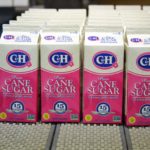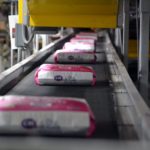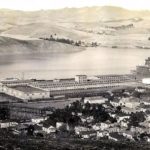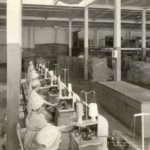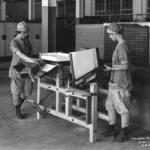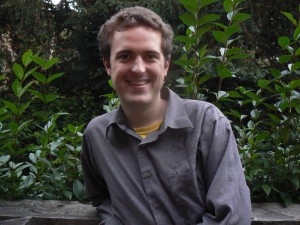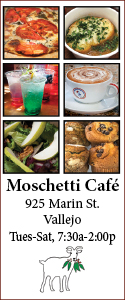By Nate Gartrell
The bright red and white lights that display the words “C and H Pure Cane Sugar” to hundreds of thousands of passersby on the Carquinez Bridge each day have become one of the most iconic sites in the Bay Area. They might be powered by modern, energy-saving LEDs, but they give off a feeling of nostalgia, a throwback to an era where red brick factories and warehouses lined the shores of the Carquinez Strait from Crockett to Martinez, when industry, fishing, and transportation by rail and ferry were the driving forces behind the local economy. The California and Hawaiian Sugar Factory was founded in 1906, though parts of the building that have made up its home are even older than that, harkening back to the late 19th century. Nearly everything about the area has changed since then—even the sugar factory’s linkage with Hawaiian cane fields—but through it all, the sugar factory has endured.
When it started, the factory employed around 500 people and produced around 67,000 tons of refined sugar per year. It now employs around 450 and produces about 10 times its 1906 levels—millions of pounds per day—accounting for roughly 14 percent of all the sugar throughout the United States.
“Today C&H produces cane sugar and molasses for a vast US market,” the factory’s website says. “The Crockett refinery processes over 700 thousand tons of cane sugar annually—more than 70 types, grades and package sizes, including packaged consumer sugars as well as packaged, liquid, and bulk granulated, industrial-use cane sugars.”
The history of the sugar factory goes back to the Gold Rush era when a man named Abraham Starr came to the Bay Area in search of fortune, at the young age of 18. While he didn’t strike it rich with a gold pan, Starr started a flour mill in Vallejo. Then, in the second half of the 19th century, he crossed the Carquinez Strait and opening a mill called Wheatport in Crockett, where C&H now stands. Before the mill could go into heavy production, the bank scare of 1893 forced Starr to sell to a businessman named G.W. McNear, who envisioned a beet sugar factory on the site. He converted the mill into just that—but as anyone at C&H will tell you—beet sugar is considered inferior to pure cane sugar. Soon, a Hawaiian ownership group took over the site and began a tradition that would hold for the next 111 years: Shipping raw sugar canes from Hawaii to Crockett, where the factory would refine it into the granulated sugar we all know and love. Crockett’s location had it all—access to the Pacific Ocean, railroad, and the highway, as well as a pre-made sugar refining plant. As another big plus to Crockett, it gave access to fresh water via the Delta (i.e., fresh water is a necessary element in the process of refining sugar), and for decades, sugar would be shipped down the Delta via the Carquinez Strait by C&H barges.
The factory has been working basically around the clock ever since 1906. After celebrating its 100th anniversary in 2006, it was bought by its current owners, the Florida-based American Sugar Refining, Inc., which runs similar factories and cane fields throughout the country.
“We ship anywhere from 90 to 100 packaged trucks every day, over 25,000 a year,” Jake Peterson, a warehouse manager, said in a video series that C&H put out in 2017. “The Crockett facility is a great Bay Area location. We actually got train tracks that run right through the facility, so we have the ability to load packaged cars and bulk rail cars if the demand is out there.”
Two years ago marked the end of an era for the sugar factory, when the last of its Hawaiian sugar plants, in Maui, shut down. In an event that would garner media attention around Northern California, the factory commemorated the arrival of the cargo ship Moku Pahu when it carried what would be the final Hawaiian shipment—30,000 tons in total—into the Crockett harbor in January 2017. That’s a typical shipment, and factory workers say the factory receives 25-30 of those annually.
“Normally in the sugar industry, sugar is stored in raw sugar sheds. But unique to Crockett, we have nine raw sugar silos. Each silo can store around 12,000 tons of raw sugar, which is 24 million pounds,” Hitesh Sharma, an engineering manager, said in one of the factory’s 2017 videos. “So with nine silos we have the capacity to store 110,000 tons of raw sugar at a time.”
The end of the Hawaiian connection was part of a nationwide decline of domestic sugar production. In keeping with its nostalgic spirit, C&H maintained its name and logo, but now its cane comes from foreign production sites in Mexico, Brazil, Australia, or Vietnam, to name a few.
“While Hawaii no longer produces raw sugar, C&H Sugar is still made with pure cane sugar, and we are very proud of our Hawaiian heritage, which is why we display the hibiscus flower on our logo,” a C&H spokesperson told Local Happenings magazine. Because the sugar factory has become a mainstay in Crockett for the bulk of the town’s history (and even though many of its employees live out of town), Crockett has become known by the nickname “Sugartown.” And every year for the past 11 years, the town’s Chamber of Commerce has commemorated the special relationship between C&H and Crockett with the Sugartown Festival, an outdoor music and street fair. It is held on the third Sunday of July, which this year falls on July 21, from 11 a.m. to 6 p.m.
“It is a great outdoor music festival and street fair,” the festival’s website says. “It is family friendly, has great arts and crafts, food, beer, wine, and live entertainment. Stroll through a shady street, enjoying the food and wine, shopping, the great arts and craft vendors while enjoying wonderful music, with two stages to choose from.”
For this year, Lagunitas Brewing Co. will host a beer garden for the festival, and the organizers say margarita fans will also be pleased. The festival will feature nine local bands, each bringing a unique flavor to the table. In chronological order, from morning to afternoon, there will be: The Rhythm Doctors (blues band), Mama Foxxy (bluegrass/folk group), the Whiskey Gipsy Rebels, the Concord “rockabilly” group Mitch Polzak, the Royal Deuces (reggae band), Planting Seeds (also based in Concord), Van Goat (Oakland-based, punk, swing, ragtime, and southern jazz band), Crockett’s own jazz orchestra called Steve Snyder’s Big Band, Louisiana BlackCat Zydeco band, the Billy Martini Show (playing ‘70s and ‘80s dance music), and the VibraSÓN Latin Band (bringing “some of the greatest musical talent the Bay Area has to offer,” its website says).
The Sugartown Festival is free to enter and will be held rain or shine! For additional information on the C&H Factory, including recipes specially made for C&H sugar, visit chsugar.com or facebook.com/CandHSugar. View a series of short videos produced by the factory, giving the public a rare look inside, at vimeo.com/chsugarcrockett.
For additional information on the Sugartown Festival, including a list of vendors and musical acts with biographies, visit sugartownfestival.com. You can also get information, or sign up to volunteer at the festival, by emailing crockettchamber@aol.com or by visiting the Crockett Chamber’s website: crockettcalifornia.com. The chamber is located at 1214 A Pomona Street in Crockett, and its mailing address is P.O. Box 191 in Crockett, CA, 94525.
- Sewing Sugar Bags
- Sugar Cube Station
Nate Gartrell grew up in Benicia, studied journalism in college, and has written for a handful of media outlets since age 15. He aspires to visit all 30 Major League Baseball stadiums and to hit the trifecta at the horse track.


